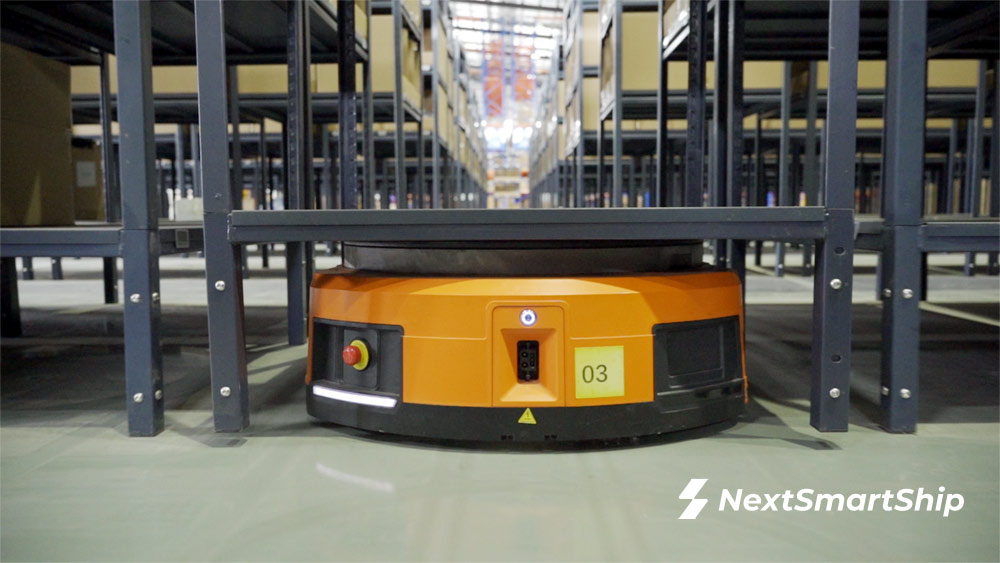The global COVID-19 pandemic accelerated people’s shift to eCommerce. Digital Commerce 360 states that online weekly shopping grew from 36% to 28%. What’s more, 75% of people prefer digital shopping options due to safety, speed, and convenience.
Logistics remains the differentiating factor in eCommerce businesses competing within the same industry. It is in warehousing and shipping where businesses stand out. The eCommerce surge has led to the realization that fulfillment centers cannot rely on human manpower alone to cater to this growing demand.
As a result, many companies have turned to automate their order fulfillment functions using AGV robots. This ensures order accuracy, faster shipping as well as turnaround times. So, what are these machines, and how will they impact fulfillment center automation?
What are AGVs?
Automated Guided Vehicles (AGVs) are customizable robots that can move items autonomously in manufacturing or fulfillment centers. When they first came out, AGVs worked by following wires or marked lines on the floor. Some models used magnets, radiowaves, or lasers to shift shipping containers or move pallets. Advancements have led to AGVs becoming more reprogrammable, eliminating the need for using magnetic strips and reflectors to control their path. The AGV industry is set to become a $2.74 billion market by 2023. Some may see these machines as a threat to the human workforce but AGVs can be used to reduce redundant tasks for workers allowing them to be reassigned to areas where they will be able to add value to your brand. Furthermore, AGVs help to avert the need to put human workers at risk by ensuring that social distancing is maintained in risky areas.
Types of Automation in a Fulfillment Center
Fulfillment center automation improves the fulfillment process by eliminating mundane tasks such as picking, packing, receiving, and documenting. This also ensures that the human workforce is protected from places that are prone to injuries.
Below are the types of automation you can expect in a fulfillment center.
Goods-to-Person
Goods-to-person (GTP) helps increase fulfillment efficiency by using vertical lift systems, carousels, and conveyors to reduce congestion. This doubles the speed of warehouse picking.
Automated Storage and Retrieval Systems (AS/RS)
AS/RS systems include automated equipment such as mini-loaders and tote shuttles that ensure a seamless storing and retrieving process for products.
AGVs

As we mentioned earlier, AGVs are automated vehicles that can load and unload pallets, boxes, and shipping containers in a fulfillment center without a human operator. AGVs not only ensure safety at the fulfillment center but also offer improved item tracking and inventory control systems.
Pick-to-light systems
These systems use mobile barcode scanning synced to LED displays to direct warehouse pickers where to pick selected items and the correct storage location. They come in handy when dealing with high-volume orders by reducing time spent by a worker to walk across shelves searching for an item.
Voice tasking
These systems use speech recognition and mobile headsets to direct warehouse procedures. It is used to facilitate the process of picking and putting away products. This eliminates having to use handheld devices like RF scanners.
Autonomous Mobile Robots (AMRs)
AMRs tend to be more flexible than AGVs as they use GPS systems to create routes across the fulfillment center. They utilize advanced laser guides to detect obstacles on their path to navigate dynamic environments that consist of human traffic.
Automated sortation systems
Sortation involves identifying products on a conveyor system and directing them to your preferred warehouse location. This is done using sensors and barcode scanners. Automated sortation systems are used for the process of picking, receiving, packing, and shipping.
Inventory automation
Inventory management systems provide storage locations, product information, and real-time visibility of stock levels. This helps to maximize scalability and decrease human error. Other ways inventory automation ensure business operations run smoothly include:
- Inventory tracking
- Managing customer order deliveries
- Maintaining reorder points
- Sharing real-time data with customers
Shipping automation
You can also automate your shipping processes using third-party shipping software like NextSmartShip. After creating an account, you can sync your orders and auto-populate shipping information to the dashboard. Shipping processes such as creating pre-filled custom forms and shipping labels as well as generating branded tracking pages can be automated.
Amazon: Fulfillment Center Automation at Work
Amazon utilizes robotic systems to make same-day delivery possible. Its warehouses are estimated to use about 200,000 mobile robots that work cohesively with its human labor force.
Amazon uses robots to automate tasks such as monitoring working to increase performance. It also has robotic mobiles that move across shelves and do the picking. Amazon has palletizers that take items from conveyor belts to required shipping pallets. It also uses robotic stows to lift pallets and put them on drive units. It’s also believed that Amazon has advanced robots that do the wrapping and packing of packages for shipping.
Benefits of Fulfillment Center Automation to eCommerce Businesses
The continuous eCommerce growth demands better systems to improve customer experience. Fulfillment is a very significant factor in ensuring that your brand stands out from your competitors because warehouse and shipping both act as backend intermediaries between your brand and your customers.
Let’s look at some of the benefits your eCommerce business gets from an automated fulfillment center.
Order accuracy
AS/RS systems have the potential of increasing order accuracy by 99.9%. Order accuracy promotes a positive customer shopping experience. Fulfillment center automation eliminates a huge percentage of human error associated with packing and shipping customer orders accelerating dispatch accuracy.
Faster shipping
Speed in delivery is a very competitive component in eCommerce. Fulfillment center automation helps to reduce congestion and increase efficiency. This simplifies the order fulfillment processes of receiving, picking as well as packing leading to increased shipping speed. It also ensures peak season readiness when demand for certain products spike and huge order volumes come flooding in.
Over to You
As eCommerce continues to boom, fulfillment center automation remains important to streamline processes and ensure customer’s expectations are met. It’s paramount to work with a fulfillment center that has embraced automation technology to ensure faster shipping and accuracy of orders for your customers.
NextSmartShip has recently acquired AGVs to boost its warehouse productivity and efficiency. If you’re looking for a fulfillment solutions partner to level up your logistics end of your eCommerce business, contact us today and we’ll help you with your fulfillment and shipping needs.



